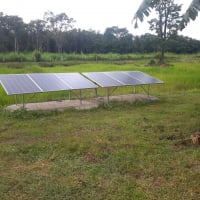12 Volt vs 24Volt nominal panels

mcgivor
Solar Expert Posts: 3,854 ✭✭✭✭✭✭
Going to build a new system for a friend, it will be a 24V nominal with PWM controller, after doing some research into panel prices, I discovered here in Thailand at least, that there is no difference in price per watt going with 12 or 24 volt panels, they all seem to be in the US. $ 0.85 range for Poly and $ 0.90 for mono regardless of wattage, So the question is which would be the best choice, electricity it wo make no difference, so it would come down to advantage versus disadvantages.
Disadvantages: 12V more panels more series connections, more mounting fasteners
Advantages: 12V easier to handle, less expensive to replace a damaged panel,
Disadvantages: 24V more difficult to handle, more expensive to replace a damaged unit
Advantages :24V fewer panels, less mounting hardware, fewer series connections
From a practical standpoint it would seem using 12V panels may be the way to go, the 60 cell panels are comparable in price but can't be used with PWM, any thoughts welcome.
Disadvantages: 12V more panels more series connections, more mounting fasteners
Advantages: 12V easier to handle, less expensive to replace a damaged panel,
Disadvantages: 24V more difficult to handle, more expensive to replace a damaged unit
Advantages :24V fewer panels, less mounting hardware, fewer series connections
From a practical standpoint it would seem using 12V panels may be the way to go, the 60 cell panels are comparable in price but can't be used with PWM, any thoughts welcome.
1500W, 6× Schutten 250W Poly panels , Schneider MPPT 60 150 CC, Schneider SW 2524 inverter, 400Ah LFP 24V nominal battery with Battery Bodyguard BMS
Second system 1890W 3 × 300W No name brand poly, 3×330 Sunsolar Poly panels, Morningstar TS 60 PWM controller, no name 2000W inverter 400Ah LFP 24V nominal battery with Daly BMS, used for water pumping and day time air conditioning.
5Kw Yanmar clone single cylinder air cooled diesel generator for rare emergency charging and welding.
Second system 1890W 3 × 300W No name brand poly, 3×330 Sunsolar Poly panels, Morningstar TS 60 PWM controller, no name 2000W inverter 400Ah LFP 24V nominal battery with Daly BMS, used for water pumping and day time air conditioning.
5Kw Yanmar clone single cylinder air cooled diesel generator for rare emergency charging and welding.
Comments
-
Unless you are building a 12 volt system I would go with the 24 volt panels saving on hardware and having fewer connections. Are these 24 volt panels built with 5" or 6" cells? The 6" cell format are large as you know and could be challenging to manipulate while up on a steep, high roof. In that case 12 volt panels might be warranted.
2.1 Kw Suntech 175 mono, Classic 200, Trace SW 4024 ( 15 years old but brand new out of sealed factory box Jan. 2015), Bogart Tri-metric, 460 Ah. 24 volt LiFePo4 battery bank. Plenty of Baja Sea of Cortez sunshine.
-
They will be low mounted for ease of maintenance, the mounting hardware is of little concern and connection wise, there will be more but each panel comes with connectors, so it is either internal or external, external connections may be easier to trouble shoot.1500W, 6× Schutten 250W Poly panels , Schneider MPPT 60 150 CC, Schneider SW 2524 inverter, 400Ah LFP 24V nominal battery with Battery Bodyguard BMS
Second system 1890W 3 × 300W No name brand poly, 3×330 Sunsolar Poly panels, Morningstar TS 60 PWM controller, no name 2000W inverter 400Ah LFP 24V nominal battery with Daly BMS, used for water pumping and day time air conditioning.
5Kw Yanmar clone single cylinder air cooled diesel generator for rare emergency charging and welding. -
In the US, "12 volt panels" (Vmp~18 volts) tend to max out in wattage in the 140 watt range or so... We can get upwards of 300 Watt Vmp~30-36 volt panels. So-about 1/2 the number of panels+connections--Always a good thing.
More or less, in the US, shipping >~140 panels goes by truck/pallets. And panels >~175 Watts need 2 people to move them around.
There can be an issue with "higher voltage" panels and 48 volt battery banks. Basically, in areas with cold weather, 2x 36 volt panels gives you Vmp-array~72 volts. That is about the absolute minimum "useful" working voltage (hot weather/cool battery bank) for a PWM charge controller and 48 volt battery bank. In cold weather locations, 3x36 volt panels gives you 108 VAC--Just about the limit (or just over) in sub zero (F) locations with a typical 140 Volt input MPPT controller (and Vmp-array~72 volts on a MPPT controller could reduce array output in hot weather).
The "doughnut hole" for high voltage panels and 48 volt battery banks is around Vmp~40-72 volt panels. Of course, we have newer MPPT controller which can support >140 Vmp input voltage (with some other limitations). And Vmp>40 volt panels are not that common around here. Lower Vmp panels, you can put 3 (or more) in series for 48 volt battery banks without issue and stay under the Varray-cold limits.
-Bill
Near San Francisco California: 3.5kWatt Grid Tied Solar power system+small backup genset -
Thanks @bb for the insight, there is actually no problem getting a MPPT controller from Morningstar, Schneider Midnight, Outback or any of the major suppliers, PWM is just the less expensive route and the advantages of MPPT are not as advantageous in a tropical environment as they would be in a temperate location. The controller in question is a Morningstar TS 60 PWM , the panels are 18V, so connected in series to charge a 24V bank should be sufficient, albeit for the number of connections, one of the disadvantages of going 24Vnominal . In short it comes down to the number of connections, I guess, unless I'm missing something.
1500W, 6× Schutten 250W Poly panels , Schneider MPPT 60 150 CC, Schneider SW 2524 inverter, 400Ah LFP 24V nominal battery with Battery Bodyguard BMS
Second system 1890W 3 × 300W No name brand poly, 3×330 Sunsolar Poly panels, Morningstar TS 60 PWM controller, no name 2000W inverter 400Ah LFP 24V nominal battery with Daly BMS, used for water pumping and day time air conditioning.
5Kw Yanmar clone single cylinder air cooled diesel generator for rare emergency charging and welding. -
Pretty much... Price per Watt--The 12 volt panels tend to be 2-3x the cost per Watt vs the large format panels in the US (large format panels tend to be high volume for Grid Tied systems--Smaller panels seem to be lower volume for the off grid folks). Obviously, more racking clamps.
Shipping costs for a couple panels is expensive--The large format tend to cost more to ship (especially to residential addresses) unless you order by the pallet.
One thing that seems to be a big issue at times--Trying to replace a failed/broken panel or add to an existing array. The GT panels seem to be in and out of a market in 18 months--So finding "matching" modules is pretty difficult. The "12 volt" modules have been fairly stable (Vmp/Imp ratings) for decade or more.
But, to this point, replacing an array (or section of array) at $1 per Watt vs 15 years ago at $5-$10 per Watt... Hard to beat the economics.
-Bill
Near San Francisco California: 3.5kWatt Grid Tied Solar power system+small backup genset -
looks like you have quite of bit of hands on with different panels and cell types .. from my point of view i could care less about system operating voltage and i care everything about panel efficiency and performance in lower/angled light ... that would be my personal deciding factor .. i'd go with a panel i know puts out well from morning to evening .. some of the mono panels are worthless imo, yeah they put out ok for a couple of hours a day on sunny days, other than that theyre junk .. the best panels ive used are poly hi-efficiency and they put out if you can see more or less ..
-
No panels will put out any worthwhile current in low light conditions, to say mono are junk and worthless is a little over the top, would agree they are not worth the extra money over poly, unless space is a consideration, but in general they both perform equally well, from my observations FWIW.bsolar said:looks like you have quite of bit of hands on with different panels and cell types .. from my point of view i could care less about system operating voltage and i care everything about panel efficiency and performance in lower/angled light ... that would be my personal deciding factor .. i'd go with a panel i know puts out well from morning to evening .. some of the mono panels are worthless imo, yeah they put out ok for a couple of hours a day on sunny days, other than that theyre junk .. the best panels ive used are poly hi-efficiency and they put out if you can see more or less ..1500W, 6× Schutten 250W Poly panels , Schneider MPPT 60 150 CC, Schneider SW 2524 inverter, 400Ah LFP 24V nominal battery with Battery Bodyguard BMS
Second system 1890W 3 × 300W No name brand poly, 3×330 Sunsolar Poly panels, Morningstar TS 60 PWM controller, no name 2000W inverter 400Ah LFP 24V nominal battery with Daly BMS, used for water pumping and day time air conditioning.
5Kw Yanmar clone single cylinder air cooled diesel generator for rare emergency charging and welding. -
I'd like to see any data that shows poly output better than mono output in a side-by-side test with both adjusted for ratings.
I am available for custom hardware/firmware development
-
Mono would have a slight edge in a comparison, actually better in lower light, by a small margin, from my observations although not scientific, same manufacturer different wattage and voltage.1500W, 6× Schutten 250W Poly panels , Schneider MPPT 60 150 CC, Schneider SW 2524 inverter, 400Ah LFP 24V nominal battery with Battery Bodyguard BMS
Second system 1890W 3 × 300W No name brand poly, 3×330 Sunsolar Poly panels, Morningstar TS 60 PWM controller, no name 2000W inverter 400Ah LFP 24V nominal battery with Daly BMS, used for water pumping and day time air conditioning.
5Kw Yanmar clone single cylinder air cooled diesel generator for rare emergency charging and welding. -
I've been playing around, testing mono vs poly differences with my current panels: 2 - 100w Renogy Mono panels and 2 - 100w Renogy Poly panels.
I think they both perform pretty close to their ratings and expectations.
The trends I've noticed so far are:
Poly panels current output varies rapidly, quickly rising and falling as light conditions change and they seem to do well with early morning/late evening light
Mono panels current output changes more slowly in changing light conditions and they out-perform the poly panels in cloudy/overcast conditions
Right now they are in 2 strings of one mono/one poly each and tracking really well with my Morningstar MPPT.Current system: 8-100w Renogy panels mono/poly, 2 strings of 4 panels in series - 24v 100Ah AGM Battleborn LiFePO4 batteries - Morningstar MPPT40 CC - 1500W Samlex PSW inverter -
well, you obviously have not done any real testing then .. monos will typically almost completely shut off in low light or partial shade and produce very little, thats why systems are designed for them to use high voltage - so the system 'still operates' but it isnt producing much at all, nothing worth mentioning anyway .. its all propaganda by the manufacturers that monos are so great .. they love selling you a 1000$ charger and complicated installation, thats what its all about, the almighty dollar ... but no, a good poly, which generally isnt available in a retail panel in the states anyway, will put out half its rating even in shade or a cloudy day .. a mono wont do that ... ever .. i made a youtube video showing a multimeter test with voltage only with a side-by-side comparison of a mono and a poly cell in a window .. its clear ... i could do more tests for amps and conditions if you want me to ... not sure about the rules for posting links here but the short vid is on youtube named -->mcgivor said:Mono would have a slight edge in a comparison, actually better in lower light, by a small margin, from my observations although not scientific, same manufacturer different wattage and voltage.monocrystalline vs polycrystalline solar cells
-
Correct, no real testing, just unscientific observations as stated, but honestly I wouldn't spend the extra for mono again, they were purchased early on for a 12V system , it seems poly have improved significantly over the last 10 years, remember the old poly panels with the large visable purple crystals? not very efficient, the newer ones are almost the same, visually, as the monocrystalline. Real life testing is valuable to all, would be interesting to see, on a larger scale, a side by side total energy produced over a period of time from equal arrays, my thinking is there would be very little difference in overall production, just my opinion. Interesting video you made by the way keep up the good work , here's a link you might find interestingbsolar said:
well, you obviously have not done any real testing then .. monos will typically almost completely shut off in low light or partial shade and produce very little, thats why systems are designed for them to use high voltage - so the system 'still operates' but it isnt producing much at all, nothing worth mentioning anyway .. its all propaganda by the manufacturers that monos are so great .. they love selling you a 1000$ charger and complicated installation, thats what its all about, the almighty dollar ... but no, a good poly, which generally isnt available in a retail panel in the states anyway, will put out half its rating even in shade or a cloudy day .. a mono wont do that ... ever .. i made a youtube video showing a multimeter test with voltage only with a side-by-side comparison of a mono and a poly cell in a window .. its clear ... i could do more tests for amps and conditions if you want me to ... not sure about the rules for posting links here but the short vid is on youtube named -->mcgivor said:Mono would have a slight edge in a comparison, actually better in lower light, by a small margin, from my observations although not scientific, same manufacturer different wattage and voltage.monocrystalline vs polycrystalline solar cells
https://www.solarquotes.com.au/blog/poly-vs-multi-crystalline-solar-panels-lets-put-this-argument-to-bed/1500W, 6× Schutten 250W Poly panels , Schneider MPPT 60 150 CC, Schneider SW 2524 inverter, 400Ah LFP 24V nominal battery with Battery Bodyguard BMS
Second system 1890W 3 × 300W No name brand poly, 3×330 Sunsolar Poly panels, Morningstar TS 60 PWM controller, no name 2000W inverter 400Ah LFP 24V nominal battery with Daly BMS, used for water pumping and day time air conditioning.
5Kw Yanmar clone single cylinder air cooled diesel generator for rare emergency charging and welding. -
Ignore the Youtube video - what matters is watts at MPP, not open circuit voltage.
I am available for custom hardware/firmware development
-
Just asking what price do you pay for controllers and where do you buy them from as i am having trouble with people on ebay i order i pay and dont recieve them on time or get them at all
-
In Australia there must be reputable dealers who sell quality products, ebay tends to be mostly low cost, small dealers, when I wanted Schneider products, I emailed them, they sent me a list of dealers in Thailand. Pricing is about the same as NAWS, store link at top left of page. Have attempted to see if I could get some items sent to Thailand, but never received a reply from sales, for whatever reason.
1500W, 6× Schutten 250W Poly panels , Schneider MPPT 60 150 CC, Schneider SW 2524 inverter, 400Ah LFP 24V nominal battery with Battery Bodyguard BMS
Second system 1890W 3 × 300W No name brand poly, 3×330 Sunsolar Poly panels, Morningstar TS 60 PWM controller, no name 2000W inverter 400Ah LFP 24V nominal battery with Daly BMS, used for water pumping and day time air conditioning.
5Kw Yanmar clone single cylinder air cooled diesel generator for rare emergency charging and welding.
Categories
- All Categories
- 233 Forum & Website
- 141 Solar Forum News and Announcements
- 1.4K Solar News, Reviews, & Product Announcements
- 199 Solar Information links & sources, event announcements
- 900 Solar Product Reviews & Opinions
- 256 Solar Skeptics, Hype, & Scams Corner
- 22.5K Solar Electric Power, Wind Power & Balance of System
- 3.5K General Solar Power Topics
- 6.7K Solar Beginners Corner
- 1K PV Installers Forum - NEC, Wiring, Installation
- 2.1K Advanced Solar Electric Technical Forum
- 5.6K Off Grid Solar & Battery Systems
- 429 Caravan, Recreational Vehicle, and Marine Power Systems
- 1.1K Grid Tie and Grid Interactive Systems
- 656 Solar Water Pumping
- 816 Wind Power Generation
- 624 Energy Use & Conservation
- 623 Discussion Forums/Café
- 315 In the Weeds--Member's Choice
- 75 Construction
- 125 New Battery Technologies
- 108 Old Battery Tech Discussions
- 3.8K Solar News - Automatic Feed
- 3.8K Solar Energy News RSS Feed


